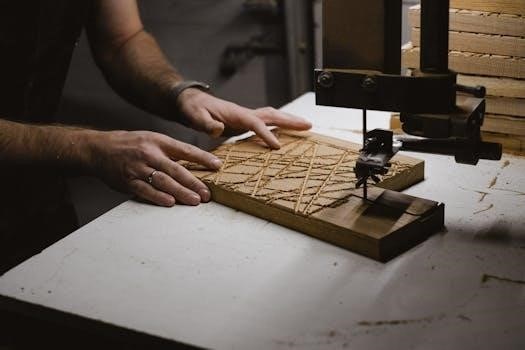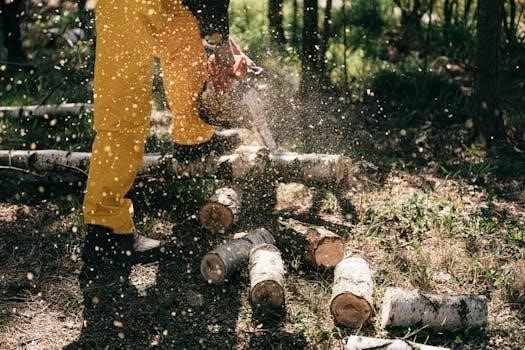Chainsaw milling is a method that uses a chainsaw and a specialized attachment to produce lumber. It provides a practical alternative to large, costly milling equipment. This technique allows for the creation of boards and slabs directly from fallen trees, offering a cost-effective solution.
Overview of Chainsaw Milling
Chainsaw milling involves using a standard chainsaw fitted with a specialized mill attachment to convert logs into lumber. This process is particularly useful for on-site lumber production, turning fallen trees into usable boards. It’s a method that allows for a more cost-effective approach than using a traditional bandsaw mill, especially when dealing with large or uniquely shaped logs. The technique is accessible to both hobbyists and professionals, offering a way to create custom lumber with minimal equipment. It transforms rough logs into valuable, usable timber.

Types of Chainsaw Mills
There are two primary types of chainsaw mills⁚ the Alaskan mill and the vertical mill. The Alaskan mill is portable and attaches to the chainsaw bar, while the vertical mill handles vertical cuts effectively.
Alaskan Mill
The Alaskan mill is a popular choice for its portability and ease of use. It attaches directly to the chainsaw’s bar, allowing for on-site milling of logs. This type of mill is renowned for its durability and precision, making it suitable for both hobbyists and professionals. It’s particularly effective for producing live-edge slabs. The Alaskan mill is a versatile tool for transforming logs into usable lumber, offering a convenient way to process timber where the tree was felled, and is a go-to option for many milling enthusiasts.
Vertical Mill
The vertical mill is designed specifically for making vertical cuts, which are useful for slicing stumps and logs into boards. This type of mill allows for processing wood that might not be suitable for an Alaskan mill, providing a different approach to lumber production. It’s particularly useful for creating dimensional lumber from larger pieces. While not as commonly used as the Alaskan mill, the vertical mill offers a valuable alternative for specific milling needs, expanding the possibilities for chainsaw lumber production and is useful for dealing with unique wood shapes.
Basic Chainsaw Milling Techniques
Basic chainsaw milling includes felling, which is cutting a standing tree, and bucking, which means cutting the tree into usable lengths. These fundamental techniques are essential for preparing logs for milling into lumber.
Felling and Bucking
Felling involves safely cutting down a standing tree, requiring careful planning and execution. Bucking follows, where the felled tree is cut into manageable lengths for milling. These are foundational techniques. When felling, a retreat path should always be planned, and the chainsaw removed and stopped as the tree begins to fall. Be alert for overhead limbs. These initial steps are crucial for successful and safe lumber production, setting the stage for further milling processes, including overbucking.
Overbucking
Overbucking is a chainsaw technique used to cut through a log or branch that is fully supported, meaning it’s not being held up by tension. This method involves cutting from the top down, carefully managing the chainsaw’s position and angle. It’s essential to maintain a steady hand and proper control of the saw to avoid kickback and achieve clean cuts. Overbucking is a key part of the milling process, facilitating the creation of usable timber from felled trees, and must be done with precision.
Essential Equipment for Chainsaw Milling
Successful chainsaw milling requires specific tools. This includes a chainsaw with sufficient power and a specialized milling attachment. Safety gear like protective clothing is also crucial for safe operation.
Chainsaw and Mill Attachment
The core of chainsaw milling is a robust chainsaw, ideally one designed for heavy-duty tasks. The saw must have enough power to handle the stresses of milling. A crucial component is the milling attachment, which guides the chainsaw to make consistent, flat cuts. The Granberg Alaskan Mill is a popular choice known for durability and ease of use. It attaches to the chainsaw bar to control the cutting depth and ensure accurate lumber production.
Safety Gear
Safety is paramount when chainsaw milling. Essential gear includes a hard hat to protect against falling debris and safety glasses to shield eyes from flying wood chips. Ear protection is crucial to prevent hearing damage from the loud chainsaw. Steel-toed boots offer protection from heavy boards and sharp edges. Additionally, wearing cut-resistant chaps or pants is vital to prevent injuries from the chainsaw. Gloves improve grip and protect hands. Always prioritize safety for a successful and injury-free milling experience.
Step-by-Step Alaskan Chainsaw Milling Process
The Alaskan chainsaw milling process involves several key steps. Begin by preparing the log, ensuring it’s stable and free of debris. Next, securely attach the Alaskan mill to your chainsaw bar. Make sure the mill is adjusted to the desired board thickness. Start your first cut using a guide board for a straight reference. Carefully push the chainsaw through the log, maintaining a steady pace. Once the initial slab is cut, repeat the process until you have the desired amount of lumber. Proper technique and patience are essential for success in this process.
Tips for Effective Chainsaw Milling
For effective chainsaw milling, maintain sharp chains regularly to ensure smooth cuts. Inspect the wood grain of the logs, choosing straight-grain ones for better quality lumber.
Maintaining Sharp Chains
Maintaining sharp chains is crucial for efficient chainsaw milling. A dull chain can lead to uneven cuts, increased strain on the saw, and reduced productivity. Regularly sharpen your chain using a file or a specialized sharpening tool. Check the chain before each milling session and sharpen it as needed to ensure smooth and accurate cuts. A sharp chain will also help to prevent the sprocket from becoming clogged which can occur during the milling process. A properly maintained chain is essential for both the quality of the lumber and the safety of the operator.
Inspecting Wood Grain
Before milling, carefully inspect the wood grain of the log. Choose logs with straight grain for better quality and more stable slabs. Logs with excessive knots or twisted grain can be challenging to mill and may result in weaker, less desirable lumber. Straight-grained logs are easier to cut, produce smoother boards, and are less likely to warp or crack. By selecting the appropriate wood grain you will get the highest quality finished lumber from your milling efforts and avoid unnecessary issues.

Hybrid Milling Techniques
Hybrid milling combines chainsaw milling with other methods, like bandsaw milling. This approach uses the chainsaw for initial sizing, followed by a bandsaw for refined cuts. This is useful for furniture-grade lumber.
Combining Chainsaw and Band Saw Milling
This technique leverages the strengths of both chainsaw and band saw mills. Initially, a chainsaw mill is used to break down a log into manageable sizes. This step is efficient for removing large portions of the log and creating rough slabs. Following this, a band saw mill is employed to achieve finer, more precise cuts, essential for creating furniture-grade lumber with smooth, accurate dimensions. This combination maximizes efficiency and quality, particularly when processing large logs for diverse applications.

Chainsaw Milling for Beginners
For those new to chainsaw milling, understanding basic setup and adjustments is crucial. This process involves learning how to properly attach and configure the mill, ensuring smooth and accurate cuts.
Setting Up and Adjustments
Setting up for chainsaw milling involves several critical steps. First, ensure the log is stable and clear of debris. Attach the chosen mill securely to your chainsaw bar, making sure it is properly aligned. Adjust the mill to your desired board thickness, usually around 2.5 inches for initial cuts. It is also important to adjust your chainsaw’s oiling system as milling will greatly increase the wear. Correct adjustments are crucial for achieving consistent and accurate lumber production, especially for beginners.

Advantages and Disadvantages of Chainsaw Milling
Chainsaw milling offers a low initial cost and portability, allowing on-site lumber production. However, it’s slower compared to band mills, and chain wear is a significant consideration.
Speed and Efficiency
Chainsaw milling is generally slower than using a band saw mill; a cut might take over 10 minutes, compared to under a minute with other methods. The speed is greatly influenced by log size and chain sharpness. However, chainsaw mills excel at producing live-edge slabs. While not the fastest method, they provide a valuable way to process logs directly where they fall. The process, although slower, can still be a productive and satisfying experience, as long as you adjust your expectations.
Cost-Effectiveness
Chainsaw milling offers a low-cost entry point into lumber production, particularly when compared to expensive band saw mills. It allows you to create boards at a fraction of the price of traditional methods, using a chainsaw and an attachment, potentially saving significant expenses. This makes it an accessible option for those who cannot afford other milling machinery. It’s a cost-effective way to convert fallen trees into valuable lumber, which makes it ideal for DIY enthusiasts and small-scale projects.
Common Mistakes and How to Avoid Them
Chainsaw milling, while effective, can lead to issues like clogging and overheating, especially with unsuitable equipment. Uneven cuts are also a frequent problem. Proper techniques and regular maintenance are crucial to avoid these common errors.
Clogging and Overheating
One frequent issue in chainsaw milling is the tendency for the sprocket area to clog with sawdust, especially when working with certain wood types like silver maple. This can lead to overheating of the chainsaw, potentially causing damage or reduced performance. To avoid this, ensure you’re using a saw appropriate for milling tasks and frequently clean the sprocket area during operation. Proper chain lubrication and sharpness also play a crucial role in preventing clogging and overheating.
Uneven Cuts
Achieving smooth, consistent cuts is essential for quality lumber, but uneven cuts can be a common challenge in chainsaw milling. This often occurs due to improper setup or technique. Maintaining a level guide board is critical to ensure the mill follows a straight path. Additionally, inconsistent pressure or a dull chain can lead to deviations. Regularly checking the mill’s alignment and the chain’s sharpness will help produce more accurate and even cuts, thereby enhancing the final product’s quality and usability.
